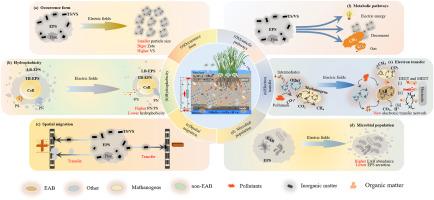人工湿地堵塞的机制和缓解控制:对生物电化学系统增强的洞察
IF 8.4
2区 环境科学与生态学
Q1 ENVIRONMENTAL SCIENCES
引用次数: 0
摘要
人工湿地作为一种经济、环保的污水处理技术,在各类污水处理中得到了广泛的应用。长期运行后,由于物理、化学和生物过程导致的堵塞物质的积累,对化粪池的性能产生一系列强烈影响。综述了堵塞形成的机理,可分为物理堵塞、化学堵塞和生物堵塞。分析了化粪池堵塞防治的典型措施。将生物电化学系统(BES),包括微生物燃料电池(mfc)和微生物电解电池(MECs)集成到化学反应器中,由于BES可以轻松地自动控制或调整其内部电场形式,因此被认为是一种安全有效的缓解现场底物堵塞的方法。全面阐述和分析了化学- bes控制堵塞的机理。在BES的帮助下,堵塞物质获得了优化的赋存在形式、降低的疏水性和有利的空间分布。此外,微生物群落的结构得到了促进,电子传递速度加快,代谢途径更加多样化。与评估化学武器堵塞的传统方法相比,MFC传感器具有快速、现场检测和非破坏性等优点。未来的研究重点应放在研究化学- bes应用的理论基础上。确保化武系统长期稳定运行。本文章由计算机程序翻译,如有差异,请以英文原文为准。

Mechanisms and mitigation control of clogging in constructed wetlands: Insight into the enhancement of the bioelectrochemical systems
Constructed wetlands (CWs), a cost-effective and eco-friendly wastewater treatment technology, are extensively applied in various types of wastewater treatment. There is a series of strong impacts on CWs performance by the accumulation of clogging matters which attribute to physical, chemical, and biological processes after the long-term operation. This paper summarizes the mechanism of clogging formation, which can be classified into physical, chemical, and biological clogging. Moreover, it analyzes the typical measures for preventing and controlling clogging in CWs. The integration of bioelectrochemical systems (BES), including microbial fuel cells (MFCs) and microbial electrolysis cells (MECs) into CWs is proposed as a safe and efficient way to alleviate substrate clogging on-site, owing to the fact that BES can easily automate the control or adjustment of its internal electric field form. The mechanism of clogging control by CW-BES is comprehensively described and analyzed. With the help of BES, the clogging substances obtained optimized occurrence form, reduced hydrophobicity and advantageous spatial distribution. Besides, the microbial community achieved promoted structure, accelerated rates of electron transfer and more diverse metabolic pathway. Compared to traditional methods for evaluating the clogging of CWs, the MFC sensor offers the advantages of being fast, enabling in-site detection, and being non-destructive. Future research should be focused on the theoretical underpinnings for putting CW-BES into practical use. Additional, efforts should be made to ensure the stable, long-term operation of CWs.
求助全文
通过发布文献求助,成功后即可免费获取论文全文。
去求助
来源期刊

Journal of Environmental Management
环境科学-环境科学
CiteScore
13.70
自引率
5.70%
发文量
2477
审稿时长
84 days
期刊介绍:
The Journal of Environmental Management is a journal for the publication of peer reviewed, original research for all aspects of management and the managed use of the environment, both natural and man-made.Critical review articles are also welcome; submission of these is strongly encouraged.
 求助内容:
求助内容: 应助结果提醒方式:
应助结果提醒方式:


